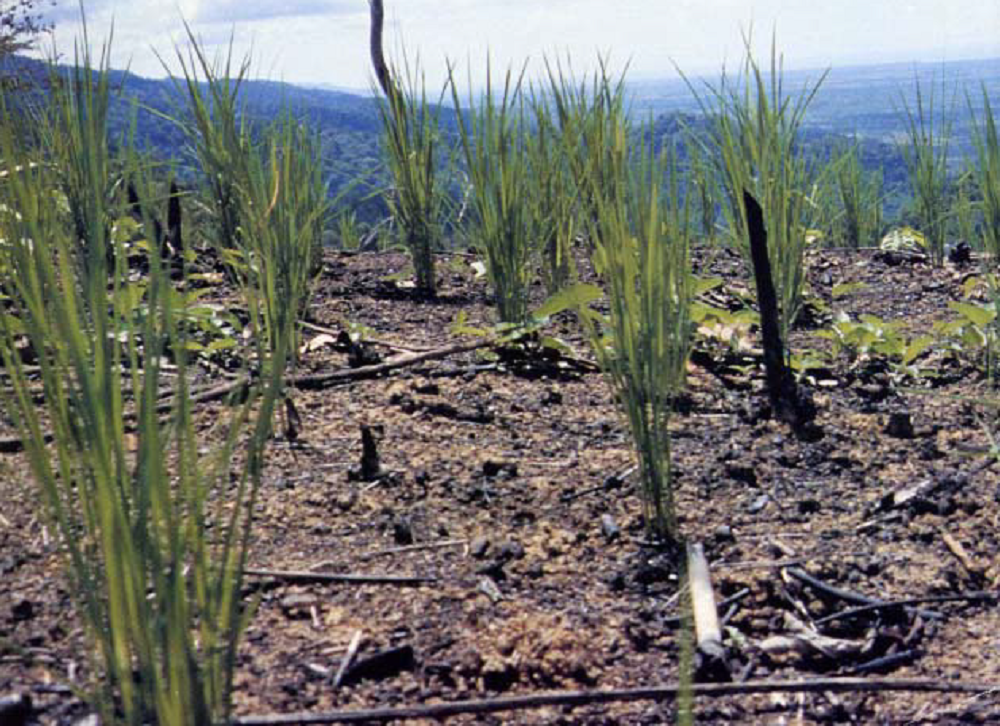The annual report for IRRI 1992-1993 highlights some of the accomplishments in research and international services to improve the well-being of present and future generations of rice farmers and consumers, particularly those with low incomes. This goal, although stated in somewhat different words, has remained essentially the same since IRRI’s founding in 1960. Given the continuing economic, social, and. environmental changes confronting the world, meeting the goal is only possible through close partnership with all concerned: public and private sectors; governments and nongovernmental organizations; and national and international research efforts.

.
Each year, the global population swells by more than 80 million people. Each year, millions of hectares of prime cropland are shifted out of agricultural production. Each year, more and more people must be fed by the food produced on less and less land, and with what is often forgotten, less water and less labor.
 The inherent challenge to agricultural research is to help farmers—in particular farmers in crucial environments of the economically less-developed countries of the world—continue to increase and sustain their productivity. But lands that are intensively cropped—pushed to produce two, three, or even more crops a year—are showing signs of stress.
The inherent challenge to agricultural research is to help farmers—in particular farmers in crucial environments of the economically less-developed countries of the world—continue to increase and sustain their productivity. But lands that are intensively cropped—pushed to produce two, three, or even more crops a year—are showing signs of stress.
Marginal lands, being forced into production as people struggle to feed themselves, are deteriorating rapidly. The high productivity agriculture made possible by today’s knowledge depends on a wide range of inputs derived from non-renewable natural resources.
- In South Asia, some 10 million hectares of highly productive irrigated ricelands—10% of the total irrigated area planted to rice in the world—are showing signs of fatigue. Up to 40% more nitrogen fertilizer is needed to produce the same amount of rice as 10 years ago. Research into the causes and into opportunities for alleviating the problem is underway.
- For the vast majority of the rice economies of the world, particularly in South and Southeast Asia where population growth is high, breaking the yield barrier is critical. But the modern high-yielding rice plant designed 30 years ago is resisting current efforts to raise its yield ceiling. Attention is on developing a new plant type designed to produce much higher yields.
- Risk of flood and drought, poor soils, diseases and insect pests, weed infestations are discouraging farmers in the less favorable rainfed lowlands from investing in the modern, high-yielding rice and inputs that would increase their production. Improved germplasm and integrated pest and nutrient management technology are being developed to reduce both the investment costs and the risks.
- The lowlands in general and irrigation systems, in particular, depend on well-preserved water catchments in the uplands. Upland rice farming families are among the world’s poorest people. Their influence on the extremely fragile upland environments has been underestimated and long-neglected. IRRI is committed to contributing to new solutions to improved living conditions in these rural environments which are often centers of important rural cultures as well.
- Farmers who crop the fragile and vulnerable delta regions of the great rivers cope daily with the constraints of uncontrolled floods, problem soils, and pests. Identifying alternatives and reducing risk in the flood.- prone areas are critical to improving their well-being and productivity.
This annual report for IRRI 1992- 1993 highlights some of our current accomplishments in research and international services. The achievements reported here are but a few examples of the Institute’s progress toward achieving its goal:
To improve the well-being of present and future generations of rice farmers and consumers, particularly those with low incomes.
This goal, although stated in somewhat different words, has remained essentially the same since IRRI’s founding in 1960. Given the continuing economic, social, and. environmental changes confronting the world, meeting the goal is only possible through close partnership with all concerned: public and private sectors; governments and nongovernmental organizations; national and international research efforts.
IRRI’s role is in improving the genetic resource base and the management of natural resources related to the cultivation of rice. These concerns were at the center of intense discussion among all IRRI staff during the last half of 1992 and into 1993, as we developed the Institute’s medium-term plan for 1994-1998. The research agenda we hammered out identifies current crucial issues and anticipates the research needed to alleviate rice production concerns of the decades ahead.
We are confident that IRRI is capable of assuming its share of responsibility for the development of more sustainable and, at the same time, more highly productive rice-based agricultural production systems. The External Review Panel that examined our programs and management in 1992 affirmed that capability. With a forward-looking program that fundamentally changed structures and facilities and strengthened scientific leadership, IRRI feels prepared for its continuing adventure in research to improve the world’s most important food crop, rice.





